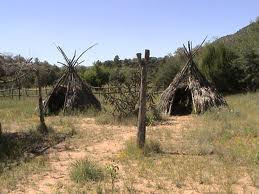Description of the Tribes that Comprise the Dakota Sioux.
The western water-shed of the Mississippi river was largely in the possession of the Dakota or Sioux stock. Its various tribes extended in an unbroken line from the Arkansas river on the south to the Saskatchewan on the north, populating the whole of the Missouri valley as far up as the Yellowstone. Their principal tribes in the south were the Quapaws, Kansas and Osages; in the central region the Poncas, Omahas and Mandans; to the north were the Sioux, Assiniboins and Crows; while about Green Bay on Lake Michigan lived the Winnebagoes.
The opinion was formerly entertained that this great family moved to the locations where they were first met from some western home; but the researches of modern students have refuted this. Mr. Dorsey has shown by an analysis of their most ancient traditions that they unanimously point to an eastern origin, and that the central and southern bands did not probably cross the Mississippi much before the fourteenth century. This is singularly supported by the discovery of Mr. Horatio Hale that the Tuteloes of Virginia were a branch of the Dakotas; and further, the investigations of Catlin among the Mandans resulted in showing that this nation reached the Missouri valley by travelling down the Ohio. They therefore formed a part of the great easterly migration of the North Atlantic tribes which seem to have been going on for many centuries before the
discovery. In the extreme south, almost on the gulf coast of Louisiana, lived some small bands of Dakotas, known as Biloxis, Opelousas, Pascagoulas, etc. They were long supposed to speak an independent tongue, and only of late years has their proper position been defined.
discovery. In the extreme south, almost on the gulf coast of Louisiana, lived some small bands of Dakotas, known as Biloxis, Opelousas, Pascagoulas, etc. They were long supposed to speak an independent tongue, and only of late years has their proper position been defined.
Their frames are powerful, and the warriors of the Sioux have long enjoyed a celebrity for their hardihood and daring. The massacre of General Custer’s command, which they executed in 1876, was the severest blow the army of the United States ever experienced at the hands of the red man. With reference to cranial form they are dolichocephalic, sixteen out of twenty-three skulls in the collection of the Academy offering a cephalic index under 80.
The northern Dakotas do not seem to have had the same system of gentes which prevailed in most of the eastern tribes. Mr. Morgan was of the opinion that it had existed, but had been lost; this, however, requires further proof. There are many societies among them, but not of the nature of clans. Their chiefs hold their position by hereditary descent in the male line, though among the Winnebagoes the early traveller, Carver found the anomaly of a woman presiding over the tribe. The central bands, the Mandans and Minnetarees, recognized gentes with descent in the female line; while among the Poncas and Omahas there were also gentes, but with descent in the male line. The condition in this respect, of the members of this family, as also of that of the Athabascan, seems to prove that the gentile
system is by no means a fixed stadium of even American ancient society, but is variable, and present or absent as circumstances may dictate.
system is by no means a fixed stadium of even American ancient society, but is variable, and present or absent as circumstances may dictate.
A few members of this family, notably the Mandans, attained a respectable degree of culture, becoming partly agricultural, and dwelling most of the year in permanent abodes; but the majority of them preferred depending on the bounties of nature, pursuing the herds of buffaloes over the boundless pastures of the plains, or snaring the abundant fish in the myriad streams which traversed their country.
The mythology of the Dakotas is concerned with the doings of giants in whom we recognize personifications of the winds and storms. One of these is Haokah, to whom the warrior sends up an invocation when about to undertake some perilous exploit. The thunder is caused by huge birds who flap their wings angrily and thus produce the portentous reverberations. The waters are the home of Unktahe, a mighty spirit who lurks in their depths. Indeed, to the Dakotas, and not to them alone, but to man in their stage of thought, “All nature is alive with gods. Every mountain, every tree is worshipped, and the commonest animals are the objects of adoration.”
DAKOTA LINGUISTIC STOCK.
- Arkansas, on lower Arkansas river.
- Assiniboins, on Saskatchewan and Assiniboin rivers.
- Biloxis, in Rapides Parish, Louisiana.
Crows, on Yellowstone river.- Iowas, on the Iowa river.
- Kansas, on the Kansas river.
- Mandans, on the middle Missouri river.
- Minetarees, on the Yellowstone river.
- Ogallalas, sub-tribe of Sioux.
- Omahas, on the Elkhorn river.
- Osages, on Arkansas and Osage rivers.
- Ottoes, on the Platte river.
- Poncas, on the middle Missouri river.
- Quapaws, on lower Arkansas river.
- Sioux, on upper Mississippi and affluents.
- Tetons, sub-tribe of Sioux.
- Tuteloes, on upper Roanoke river, Va.
- Winnebagoes, western shore of Lake Michigan.
- Yanktons, on upper Iowa river.






















































.jpg)

